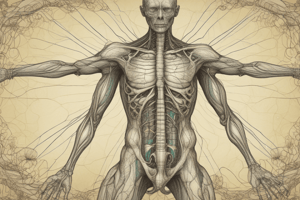Podcast
Questions and Answers
What is the main function of the lymphatic system?
What is the main function of the lymphatic system?
- Drains excess interstitial fluid (correct)
- Assists in digestion
- Carries out respiratory functions
- Transports oxygen in the body
Lymphatic vessels resemble small ____ in structure but have thinner walls and more valves.
Lymphatic vessels resemble small ____ in structure but have thinner walls and more valves.
veins
Deep cervical lymph nodes receive all the lymph from the head and neck via the superficial lymph nodes.
Deep cervical lymph nodes receive all the lymph from the head and neck via the superficial lymph nodes.
True (A)
Match the following lymph nodes with their locations: 1. Parotid Lymph Nodes 2. Submental Lymph Nodes 3. Jugulodigastric Lymph Nodes
Match the following lymph nodes with their locations: 1. Parotid Lymph Nodes 2. Submental Lymph Nodes 3. Jugulodigastric Lymph Nodes
Flashcards are hidden until you start studying
Study Notes
Lymphatic System
- Consists of: fluid (lymph), vessels that transport lymph, and structures and organs containing lymphatic tissue
- Lymphatic tissue is a specialized form of reticular connective tissue that contains lymphocytes (agranular white blood cells, e.g. thymus, lymph nodes)
Functions of Lymphatic System
- Drains excess interstitial fluid
- Transports dietary lipids
- Carries out immune responses
Lymphatic Vessels
- Begin as lymphatic capillaries, which are located in the spaces between cells and unite to form lymphatic vessels
- Resemble small veins in structure but have thinner walls and more valves
- Lie in the subcutaneous tissue and generally follow the same route as veins
- Lymphatic vessels of the viscera generally follow arteries
Lymphatic Capillaries
- Have greater permeability and are larger in diameter than blood capillaries
- Can absorb large molecules such as proteins and lipids
- Have a one-way structure
Lymph Trunks and Ducts
- Formed by the unity of efferent lymphatic vessels from lymph nodes
- Lymph trunks combine to form lymph ducts, which empty into the venous system
Lymphatic Drainage of the Head and Neck
- Divided into two major groups: superficial and deep
- Superficial vessels drain lymph from the scalp, face, and neck into the superficial ring of lymph nodes at the junction of the head and neck
- Deep vessels arise from the deep cervical lymph nodes and converge to form the left and right jugular lymphatic trunks
Lymph Nodes
- Can be divided into two groups: superficial and deep
- Superficial lymph nodes receive lymph from the scalp, face, and neck and ultimately drain into the deep lymph nodes
- Deep lymph nodes receive all of the lymph from the head and neck via the superficial lymph nodes
Lymph Nodes of the Head and Neck
- Occipital lymph nodes: usually 1-3, located in the back of the head, collect lymph from the occipital area of the scalp
- Mastoid lymph nodes: located posterior to the ear, collect lymph from the posterior neck, upper ear, and back of the EAM
- Pre-auricular lymph nodes: located anterior to the auricle, collect lymph from superficial areas of the face and temporal region
- Parotid lymph nodes: located superficial to the parotid gland, collect lymph from the nose, nasal cavity, EAM, TM, and lateral borders of the orbit
- Submental lymph nodes: located superficial to the mylohyoid muscle, collect lymph from the central lower lip, floor of the mouth, and apex of the tongue
- Submandibular lymph nodes: located below the mandible, collect lymph from the cheeks, lateral aspect of the nose, upper lip, lateral parts of the lower lip, gums, and anterior tongue
Lymph Node Levels of the Neck
- Level Ia: Submental group, contains submental nodal group, drains the skin of the chin, mid-lower lip, anterior portion of the oral tongue, and the floor of the mouth
- Level Ib: Submandibular group, contains submandibular nodal group, drains the efferent lymphatics from level Ia, lower nasal cavity, soft and hard palates, and maxillary and mandibular alveolar ridges
- Level II: Upper Jugular group, contains the upper jugular nodal group, drains the efferent lymphatics from the face, parotid, level Ia & Ib, and retropharyngeal nodes
- Level III: Middle Jugular group, drains lymph from level II & V, and partially from the retropharyngeal, pretracheal, and recurrent laryngeal nodes
- Level IV: Lower Jugular group, drains lymphatics from levels III & V, and partially from the retropharyngeal, pretracheal, and recurrent laryngeal nodes
- Level V: Posterior Triangle group, contained within the posterior triangle, drains the lymphatics from the occipital, retro-auricular, occipital, and parietal scalp nodes
- Level VI: Anterior Compartment group, drains the integuments of the lower face and the anterior neck, and the lymphatics from the anterior floor of the mouth, tip of the oral tongue, lower lip, thyroid, glottic and supraglottic larynx, hypopharynx, and cervical esophagus
Studying That Suits You
Use AI to generate personalized quizzes and flashcards to suit your learning preferences.




